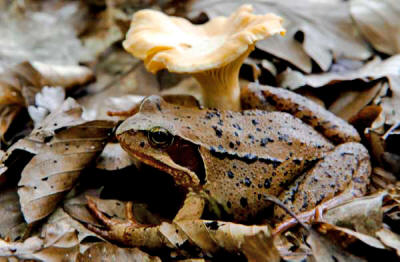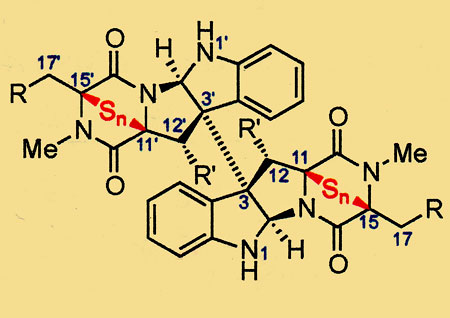|

February 27,
2013
from
ITechPost Website

A wood frog rests
beside a chanterelle mushroom.
Credit:Reuters
Chemists at MIT are testing compounds based on a chemical secreted
by fungi. The compounds could potentially be used in formulating
drugs to treat cancer.
Years ago, a team led by Mohammed Movassaghi, associate
professor at MIT, synthesized a complex fungal compound. Previous
studies of the compound called 11, 11'-dideoxyverticillin found that
it exhibited cancer-fighting characteristics.
Movassaghi asserts that
a more comprehensive study has to be conducted to determine drug
development possibilities.
"There's a lot of
data out there, very exciting data, but one thing we were
interested in doing is taking a large panel of these compounds,
and for the first time, evaluating them in a uniform manner,"
said Movassaghi.
Scientists believe that
compounds naturally produced by fungi known as
pipolythiodiketopiperazine (ETP) alkaloids are emitted to help fungi
fight organisms that try to invade their territory.
The researchers synthesized natural ETP in the lab and produced
similar compounds that they believed the have anti-cancer
characteristics. More compounds were created for the new study,
forming a variety by either adding or removing chemical groups.
The study was published in Chemical Science online, explaining how
60 compounds were designed and tested for their ability to destroy
cancer cells.
"What was
particularly exciting to us was to see, across various cancer
cell lines, that some of them are quite potent," said Movassaghi.
The 60 compounds were
tested on two human cancers, cervical cancer and lymphoma.
Lung, kidney and breast
cancers were later tested using 25 of the best compounds. It was
found that dimeric compounds, formed by combining two identical
molecules, were more effective at killing cancer cells compared to
monomers, which are single-molecule compounds.
The compounds were
selective and destroyed cancer cells 1,000 times greater than
they did healthy blood cells.
The research team included Movassaghi and his colleagues at MIT and
the University of Illinois at Urbana-Champaign (UIUC). Nicolas
Boyer, an MIT postdoc, is the lead author of the paper.
Many antibiotics, including penicillin, were derived from chemicals
extracted from or based on chemicals from fungi. Alexander
Fleming made the discovery in 1929 that the fungal contaminant
described as "Penicillium notatum" was effective against many forms
of bacteria.
Chemists Find Help from Nature in
Fighting Cancer
-
Research Update -
by Anne
Trafton
MIT News Office
February 27, 2013
from
MIT Website
Study of
several dozen compounds
based on a
fungal chemical
shows potent
anti-tumor activity.

MIT chemists designed
many variants
of
epipolythiodiketopiperazine (ETP) alkaloids
and tested them for
anticancer activity.
A representative ETP
structure is shown.
Graphic courtesy of the researchers
Inspired by a chemical
that fungi secrete to defend their territory, MIT chemists have
synthesized and tested several dozen compounds that may hold promise
as potential cancer drugs.
A few years ago, MIT researchers led by associate professor of
chemistry Mohammad Movassaghi became the first to chemically
synthesize 11,11’-dideoxyverticillin, a highly complex fungal
compound that has shown anti-cancer activity in previous studies.
This and related
compounds naturally occur in such small amounts that it has been
difficult to do a comprehensive study of the relationship between
the compound’s structure and its activity - research that could aid
drug development, Movassaghi says.
“There’s a lot of
data out there, very exciting data, but one thing we were
interested in doing is taking a large panel of these compounds,
and for the first time, evaluating them in a uniform manner,”
Movassaghi says.
In the new study,
recently published online in the journal Chemical Science (Synthesis
and Anticancer Activity of Epipolythiodiketopiperazine Alkaloids),
Movassaghi and colleagues at MIT and the University of Illinois
at Urbana-Champaign (UIUC) designed and tested 60 compounds for
their ability to kill human cancer cells.
“What was
particularly exciting to us was to see, across various cancer
cell lines, that some of them are quite potent,” Movassaghi
says.
Lead author of the paper
is MIT postdoc Nicolas Boyer.
Other authors are MIT
graduate student Justin Kim, UIUC chemistry professor Paul Hergenrother and UIUC graduate student
Karen Morrison.
Improving
nature’s design
Many of the compounds tested in this study, known as
epipolythiodiketopiperazine (ETP) alkaloids, are naturally produced
by fungi. Scientists believe these compounds help fungi prevent
other organisms from encroaching on their territory.
In the process of synthesizing ETP natural products in their lab,
the MIT researchers produced many similar compounds that they
suspected might also have anti-cancer activity. For the new study,
they created even more compounds by systematically varying the
natural structures - adding or removing certain chemical groups from
different locations.
The researchers tested 60 compounds against two different human
cancer cell lines - cervical cancer and lymphoma.
Then they chose the best
25 to test against three additional lines, from lung, kidney and
breast tumors. Overall, dimeric compounds - those with two ETP
molecules joined together - appeared to be more effective at killing
cancer cells than single molecules (known as monomers).
The structure of an ETP natural product typically has at least one
set of fused rings containing one or more sulfur atoms that link to
a six-member ring known as a cyclo-dipeptide.
The researchers found
that another key to tumor-killing ability is the arrangement and
number of these sulfur atoms: Compounds with at least two sulfur
atoms were the most effective, those with only one sulfur atom were
less effective, and those without sulfur did not kill tumor cells
efficiently.
Other rings typically have chemical groups of varying sizes attached
in certain positions; a key position is that next to the ETP ring.
The researchers found that the larger this group, the more powerful
the compound was against cancer.
The compounds that kill cancer cells appear to be very selective,
destroying them 1,000 times more effectively than they kill healthy
blood cells.
The researchers also identified sections of the compounds that can
be altered without discernibly changing their activity.
This is useful because
it could allow chemists to use those points to attach the compounds
to a delivery agent such as an antibody that would target them to
cancer cells, without impairing their cancer-killing ability.
Complex
synthesis
Larry Overman, a professor of chemistry at the University of
California at Irvine, says the new study is an impressive advance.
“Movassaghi and
coworkers reveal for the first time a number of relationships
between the chemical structure of molecules in the ETP series
and their in-vitro anti-cancer activity,” says Overman, who was
not part of the research team.
“Knowledge of this
type will be essential for the future development of ETP-type
molecules into attractive clinical candidates and potential
novel anti-cancer drugs.”
Now that they have some
initial data, the researchers can use their findings to design
additional compounds that might be even more effective.
“We can go in with
far greater precision and test the hypotheses we’re developing
in terms of what portions of the molecules are most significant
at retaining or enhancing biological activity,” Movassaghi says.
The research was funded
by the National Institute of General Medical Sciences.
|



